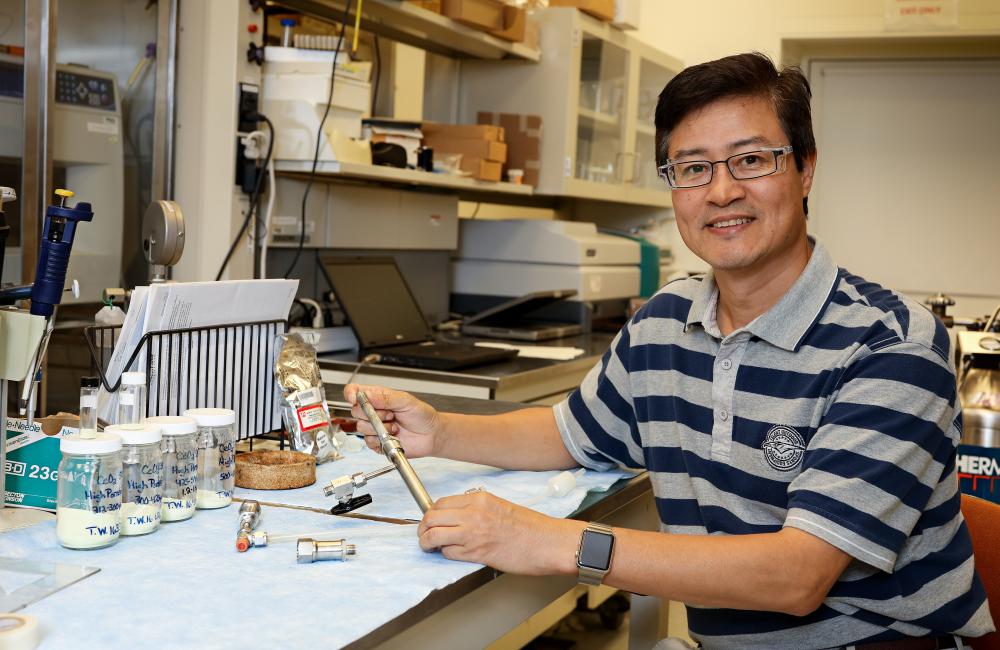Chemical and biomolecular engineer Michael Hu has spent his career devising novel means to filter, separate, and select desirable materials from liquids and gases with an eye toward better biofuels, biochemicals, pharmaceuticals, and other products—and is setting his sights on applying the technology to clean water research.
Hu is a senior research member in the Energy and Transportation Science Division at Oak Ridge National Laboratory (ORNL), focused on nanoscale synthesis, analysis, and engineering of new materials and methods to enhance separations. He recently spearheaded the development of a new class of porous, inorganic membranes nano-engineered for pore size and selectivity to separate molecules during biofuel processing.
The super-hydro-tunable high-performance architecture surface-selective (HiPAS) membranes separate molecules in both the liquid and vapor phase with higher throughput and less fouling of membrane pores than similar materials. They were developed initially under an advanced membranes program for the U.S. Department of Energy’s (DOE’s) Bioenergy Technologies Office, and garnered the team an R&D 100 award. Further research and improvements on the membranes continues today.
As part of his work, Hu is the team lead for thermochemical processing under the DOE Bioprocessing Separations Consortium, leading scientists from eight national laboratories as they develop breakthrough methods for separations to minimize the operation cost of expensive catalysts.
“If we can control the assembly and interface of materials at a very fine scale—at the molecular level—then we can create new materials with enhanced properties and make huge advancements in separations technologies of membranes and adsorbents. We’re already demonstrating some of those breakthroughs,” Hu said.
The HiPAS membranes have shown never-before-achieved throughput, or “flux rate” across their surface, making them ideal for an industrial environment of continuous operation under high temperatures and pressures, such as pyrolytic bio-oil processing. In contrast, traditional membranes often suffer from reduced throughput as their selectivity for targeted molecules increases.
The same basic science can be applied to develop clean water technologies, he noted. Hu sees promise, for instance, in the use of nanotechnology to functionalize and hybridize the surfaces of separations materials for desalination. Water and ion transport property of the nanoscale interfaces is key to future technologies, he added.
“I see many opportunities in the clean water space. We can establish signature capabilities in this area using our fundamental science program aided by advanced microscopy and the use of neutrons to examine materials at the molecular level,” he said.
The art of chemistry
Hu began advancing nanomaterials science in the mid-1990s shortly after his hire as full-time staff. He came to the lab as a post-doctoral researcher in 1993 in what was then the Chemical Technology Division at ORNL, developing biomolecule-grafted hybrid polymer materials, biomass and biosorbent materials, and separation technologies for environmental remediation and uranium recovery applications. He first heard about ORNL while conducting thesis work on lignin biodegradation as he pursued a Ph.D. in chemical engineering with a bioengineering focus at the University of Idaho, Moscow.
While growing up in China, Hu developed an interest in both engineering and music, becoming quite proficient on the violin by his teenage years. When it was time to consider college, Hu was ready to head for music school. But an older brother convinced Hu to pursue science instead.
“I put the violin on the shelf and dedicated myself to studying for college entrance exams,” Hu recalled. “I did well and had an opportunity to go to one of the best universities for chemical engineering”—the Nanjing Institute of Chemical Technology—where he earned both his bachelor’s and master’s degrees in the subject.
The violin did not stay on the shelf forever; in his spare time Hu continues to play both that instrument and the guitar. He taught his own children to play and tutors the children of close friends. “It’s important for kids to have music; it gives them something to enjoy and helps build confidence. For me, it helps me think creatively and is a great stress reliever,” said Hu, whose favorite pieces range from classical to pop and country.
With his own children now grown, Hu said his research has become almost like his music. He finds excitement in exploring the possibilities of materials nanoengineering. “It’s a fascinating field. The work evolves with time. You have to do your homework and self-educate yourself to keep up with the latest,” he noted.
Hu enjoys the collaborative nature of his work at the lab, and the ability to take advantage of unmatched capabilities for nanoscience, including the use of the Spallation Neutron Source (SNS) and the High Flux Isotope Reactor (HFIR), both DOE Office of Science User Facilities at ORNL.
“World-class research facilities and collaborative teamwork to achieve something bigger in science and technology are two main reasons why I have stayed here,” Hu said.
In addition to his time at the national lab, Hu is a joint faculty professor of chemical and biomolecular engineering at the University of Tennessee (UT), is founding editor-in-chief of the Journal of Nanomaterials, and associate editor for the Journal of Nanoscience and Nanotechnology. Although Hu has taught at UT and other colleges in the past, he now spends more time mentoring young scientists at ORNL.
“When we do breakthrough research like with HiPAS, it means payback for the lab and for my colleagues,” Hu said. “I don’t care about titles or fame—catching those plums as they fall. I want to be a creative contributor to a good, solid foundation of basic nanoengineering science that can move us forward, and to educate the next generation as it comes along.”
ORNL is managed by UT-Battelle for DOE’s Office of Science, the single largest supporter of basic research in the physical sciences in the United States. DOE’s Office of Science is working to address some of the most pressing challenges of our time. For more information, please visit energy.gov/science.



